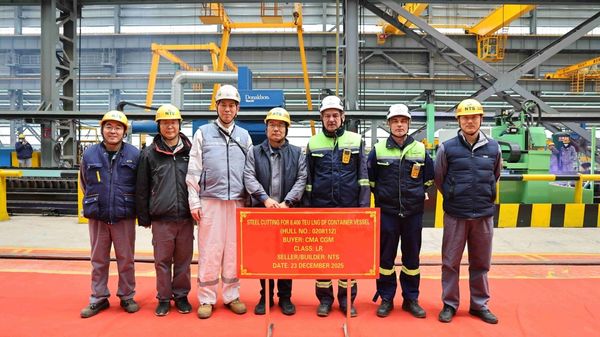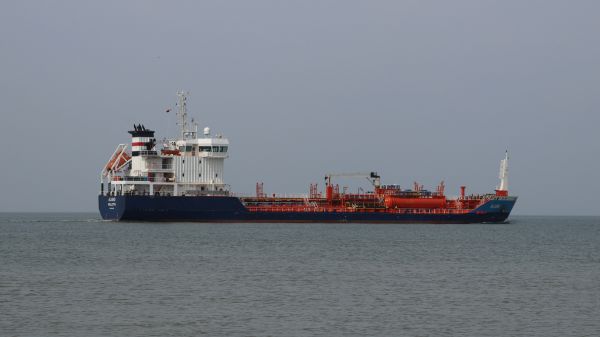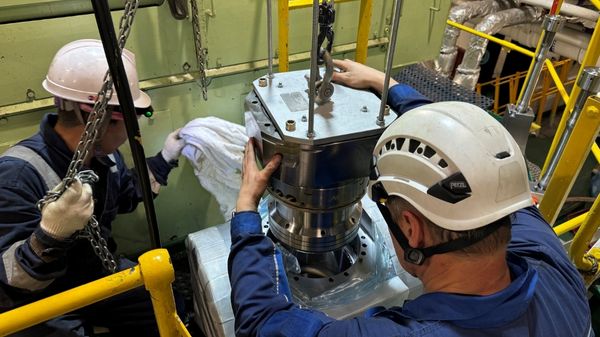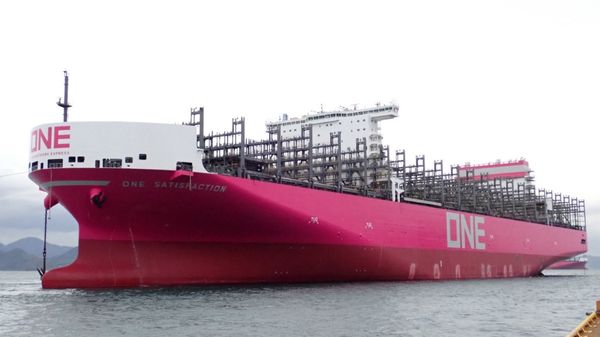Overall confidence levels in the shipping industry fell during the three months to November 2014 to their lowest level for two years, according to the latest Shipping Confidence Survey from international accountant and shipping adviser
Moore Stephens.
The survey revealed increasing concern about the high cost of achieving compliance with new regulations, and ongoing doubts about overtonnaging. But it was not all bad news, with charterers, managers and brokers all more confident than they were three months previously of making a new investment over the coming year.
In November 2014, the average confidence level expressed by respondents in the markets in which they operate was 5.7 on a scale of 1 (low) to 10 (high), down from the 6.1 recorded in August 2014. This compares to the record high of 6.8 when the survey was launched in May 2008.
All categories of respondent recorded a fall in confidence this time, most notably charterers (down to 5.4 from a record high of 6.7 three months ago) and owners (down from 6.2 to 5.5). Confidence on the part of managers, meanwhile, fell marginally from 6.2 to 6.1, while for brokers it was down from 5.3 to 5.0. Geographically, confidence was down in Asia and Europe to 5.8 and 5.6 respectively from the levels of 6.0 and 6.1 recorded three months previously. Confidence in North America, however, held steady at 6.2.
A number of respondents referred to continuing uncertainty in the markets, resulting from a variety of factors. One said, “The market remains directionless. It needs accelerated scrapping, which would make economic sense for owners of older tonnage. But, given the recent drop in fuel costs, such owners could elect to hold on to their ships for the time being.”
One respondent predicted, “Most sectors will continue to struggle along the bottom, kept alive by low interest rates,” while another felt, “There is still too much capacity and an unreasonable expectation of performance levels, given all the new ordering that is taking place.”
Not everybody was quite so pessimistic, however. One respondent said, “The global markets are expected to pick up around mid-2015,” but warned that the viability of shipping depended on the scrapping of 60 percent of all vessels over 20 years’ old and on a drastic reduction in the number of new vessels being built.
One respondent predicted, “The shipping market will improve slightly over the next few months as it mirrors the slow improvement in global markets.” But not everybody agreed. “The road to recovery is very long and very hard,” said one respondent. “Europe is still struggling and it seems unlikely that things will improve soon, even if demand for shipping increases in other parts of the world where the economy is faring better.” Another noted, “The world economy is not as healthy as expected. China has changed its growth model, while Europe is struggling under austerity measures and a lack of investment. The US may be in better health, but it is not able to drag shipping out of the doldrums in the short term.”
Elsewhere it was noted, “We are heading for a low level of activity in all markets. With sanctions on Russia and Iran, and fighting in Iraq and Syria and elsewhere, people are spending less money, which results in fewer cargo movements.”
The cost of meeting the growing regulatory burden in the shipping industry was high on the list of concerns expressed by respondents, one of whom noted, “The ballast water treatment legislation hangs like a dark cloud over all technical ship managers. This represents a huge investment accompanied by a high level of risk.” Another observed, “Regulation is becoming stricter, and now accounts for a greater slice of operational expenses than it did a few years ago. This is bad. But it is the only way to push older tonnage out of the market.”
Another respondent emphasised, “There seems to be a lack of willingness to acknowledge the negligible level of pollution caused by shipping in relation to the volume of merchandise which is shipped globally.” Other comments included, “New EU environmental regulations will have a knock-on effect beyond the primary maritime industries,” and, “Freight rates will not compensate completely for the additional cost involved in operating on low-sulphur fuel.”
Responses to the survey were completed before the announcement of the bankruptcy filing of OW Bunker, the industry’s largest fuel supplier. But a number of comments referred to the significant role played by fuel costs in the fortunes of the shipping industry, such as the respondents who noted, “High fuel costs and operating costs kill small shipowners,” and, “Bunker rates will fall still further.” Another pointed out, “Bunker prices are currently low but, with new sulphur regulations coming in, customers are receiving a very mixed message. Nobody knows what the fuel price will be in six months’ time.”
Elsewhere it was noted, “New fuel types developed to achieve environmental compliance will have a major impact on vessel operations, but there is great uncertainty about how many incompatible variants will be available on the market. Vessels operating on a worldwide basis will face fuel compatibility challenges.”
Meanwhile, a number of respondents warned that there were still too many ships available for the cargoes on offer. “As long as an insufficient level of old tonnage is being scrapped,” said one, “and until investors in newbuildings get a grip, the situation will continue to get worse.” Another observed, “It is already six years since the downturn in the freight markets and, despite there being no ground for a sustained upturn, new tonnage continues to be ordered. We have no explanation for this.”
Elsewhere it was pointed out, “Over-ordering will continue to slow the rate of recovery for the foreseeable future, but this will not stop owners buying while vessels are so cheap.” Another respondent said, “Given the overarching fundamental problem of overcapacity, every new ship entering the market will add to the lingering fear of a collapse in freight rates.”
The likelihood of respondents making a major investment or significant development over the next twelve months was down marginally on the previous survey, on a scale of 1 to 10, from 5.4 to 5.3, the lowest figure recorded in this respect since August 2012. Despite this, the figures for brokers, managers and charterers were all up, in the case of the first two by two points to 4.7 and 5.8 respectively, and in the case of the latter by one point, from 5.5 to 5.6. Expectations on the part of owners in this regard, meanwhile, were down from 5.6 to 5.1.
Forty percent of managers, as opposed to 38 per cent last time, rated the likelihood of making a new investment over the next twelve months at 7.0 out of 10.0 or higher, while 38 percent of charterers (up from 21 percent in August 2014) were of like mind. Meanwhile, the 36 percent of owners anticipating making a new investment over the coming year this time was down on the previous figure of 41 percent.
Geographically, expectation levels of major investments were unchanged in Asia at 5.2, but down in Europe, from 5.4 to 5.2, and from 5.6 to 5.3 in North America, where 33 percent of respondents rated the likelihood of making a new investment over the next twelve months at 7.0 out of 10.0 or higher, as opposed to 22 percent in the previous survey.
Comments from respondents in this regard focused largely on the growth of private equity funding in shipping. One said, “The ongoing attack on shipping by private equity investors and outsiders is still active. Until this stops, shipping does not stand a chance of producing decent returns for the historic shipowner who invests in shipping for the long term. With low yields still in place around the world, returns required by public companies and private equity investors are tragically low, so they invest in projects they really shouldn't be investing in. In addition, the new Master Limited Partnership structure is reducing required returns still further. Shipping has no place in the MLP world.”
Demand trends, competition and finance costs, in that order, once again featured as the top three factors cited by respondents overall as those likely to influence performance most significantly over the coming twelve months. The overall numbers for demand trends were up from last time from 23 percent to 25 percent, while those for competition and finance costs were unchanged at 20 percent and 14 percent respectively. Tonnage supply (down one percentage point to 13 percent) featured in fourth place, while operating costs (unchanged at 10 percent) and fuel costs (down 2 percentage points to a four-year low of 7 percent) featured in fifth and sixth places respectively.
Demand trends, up 4 percentage points to 27 percent, remained the number one performance-affecting factor for owners. Tonnage supply (unchanged at 18 percent) and competition (down one percentage point to 17 percent) featured in second and third places respectively. For managers, meanwhile, competition (down 3 percentage points to 18 percent) remained in first place, while demand trends (up 2 percentage points to 17 percent) replaced finance costs (down 2 percentage points to 15 percent) in second place. For charterers, competition (up 15 percentage points to 31 percent) pushed demand trends (up by 5 percentage points to 30 percent) into second place, with finance costs (unchanged at 16 percent) in third position.
Geographically, demand trends were the most significant factor for respondents in Asia (unchanged at 20 percent), Europe (up 3 percentage point to 27 percent) and North America (up 9 percentage points to 37 percent). Competition was the second most significant performance-affecting factor in Asia (down 2 percentage points to 19 percent), Europe (up one percentage point to 20 percent) and in North America (unchanged at 20 percent). In both Asia (up by one percentage point to 14 percent) and North America (down by 2 percentage points to 13 percent), finance costs featured in third position, while in Europe it was tonnage supply (unchanged at 15 percent) which occupied third place.
One respondent noted succinctly, “There is too much competition, too many ships, and not enough cargo.” Another observed, “If continued access to low-cost ship finance persists and encourages still more owners to order additional tonnage - especially in the tramp shipping sector - the prospect of a sustained freight market recovery taking hold will recede even further into the distance.”
The number of respondents overall who expected finance costs to increase over the next twelve months was up by one percentage point to 40 percent. For both charterers and managers, the increase was 9 percentage points to 38 percent and 45 percent respectively, while for owners there was a one percentage point increase to 40 percent. Brokers (down from 44 percent to 36 percent) were the only category of main respondent to record a lower expectation of higher finance costs.
The number of respondents in Asia anticipating an increase in the cost of finance was up by 3 percentage points to 48 percent, Europe was unchanged at 35 percent, and in North America there was an 11 percentage-point fall to 56 percent.
One respondent said, “In some cases, little if any of the financing loan will have been paid off against ships which are now approaching their first special survey and which will have suffered a huge depreciation in value due to age and the current low market.” Another noted, “There is concern about the influence wielded by irresponsible hedge funds which do not understand the nature of the business and the risks involved.”
Turning to the freight markets, there was a fall in the number of respondents anticipating higher rates in the tanker, dry bulk and container ship trades.
The number of respondents overall expecting higher rates in the tanker sector over the next twelve months fell by one percentage point to 40 percent. The views of owners (up 10 percentage points to 51 percent) differed greatly in this regard from those of managers (down 7 percentage points to 36 percent), charterers (down 5 percentage points to 33 percent) and brokers (down by 28 percentage points to 30 percent).
Geographically, the prospects for increased tanker rates were up in Asia (by one percentage point to 41 percent) and in North America (from 29 percent to 44 percent) but down in Europe, from 42 percent to 38 percent.
One respondent said, “Overtonnaging in the tanker sector will greatly affect rates for years to come, even if there is real economic growth of the sort we need. The market is ever more unpredictable.”
In the dry bulk sector, meanwhile, there was a 12 percentage-point fall, to 35 percent, in the overall numbers anticipating rate increases. Just 36 percent of charterers, compared to 64 percent last time, thought that dry bulk rates would go up over the coming year. The numbers for all other main respondents were also down, in the case of brokers by 24 percent to 19 percent, and in the case of managers by 10 percent to 33 percent. Fifty percent of owners, compared to 55 percent last time, expected rates to increase.
Geographically, the prospects for increased dry bulk rates were down in Asia by 17 percentage points to 38 percent, and in Europe, from 47 percent to 35 percent. Such prospects in North America, meanwhile, were unchanged at 14 per cent.
“There is oversupply in the world bulker fleet for the available cargo supply,” noted one respondent. “If demand for raw and or semi-raw materials does not increase, we can write off another year.”
In the container ship market, meanwhile, the number of respondents expecting rates to increase over the coming twelve months was down by 6 percentage points to 25 percent. The number of charterers anticipating higher rates was down by 15 percentage points on last time to 25 percent, while for owners the drop was from 42 percent to 40 percent. Managers (up from 18 percent to 22 percent) were the only category of main respondent more confident this time than in August 2014 of higher container ship rates over the coming year. Geographically, expectations of improved container ship rates were unchanged in Asia at 32 percent, but down in in Europe from 34 percent to 23 percent.
Moore Stephens shipping partner,
Richard Greiner, says, “Confidence in the shipping industry is at its lowest level for two years, just nine months after reaching a six-year high. A rating of 5.7 out of 10.0 may still be reasonably good in comparison with many other industries, but shipping’s failure to build on the growth in confidence reported in 2013 and early 2014 is undeniably a disappointment.
“The main reason for this may well be the one advanced by the respondent to our survey who complained of ‘too much competition, too many ships, and not enough cargo.’ Add to that the adverse effect which those three factors have on freight rates, and you have some measure of the problems currently facing the industry.
“Meanwhile, shipping continues to pay for the very international nature of the business which, perversely, is also its strength. Ongoing political unrest involving the Middle East and Ukraine does nothing to encourage growth in seaborne trade, while the global economic recovery which appeared to be under way at the beginning of the year seems to have stalled in a number of countries. The Japanese economy is in recession, France has been cast in some circles in the unfamiliar role of the sick man of Europe, and even the newly prosperous economies of China and India are currently performing below expectation.
“The cost of existing and impending regulation in shipping is another problem which is international in nature. Such costs were a recurring theme in the responses to our survey. Sulphur emissions regulations will make shipping an even cleaner and greener industry than it already is, and will encourage the development of more eco-friendly tonnage, but they come at a hefty price. Even that, however, may be small change compared to achieving compliance with the BWT convention which is now very close to ratification. To all this must be added a predicted rise in operating costs of almost three percent this year and next. But it is not all bad news.
“Shipping is still attracting investment. It may not be the type of investment which die-hard traditionalists would prefer, but private equity investors are not known for throwing their money away on lost causes. Oil (and therefore bunker) prices continue to fall, which should have a positive effect on voyage expenses for as long as it lasts. Meanwhile, cargo continues to move, if not always in the volumes and at the rates the industry would like.
“Shipping confidence began 2014 on a high. It is evident that, for now, some of that confidence has been rendered fragile and replaced by a degree of uncertainty. Some of that uncertainty may be resolved in 2015 as the extent of regulatory costs becomes clearer, and the success of recent attempts to reduce overtonnaging can be reassessed. Nevertheless, the market is likely to remain volatile in 2015 as shipping attempts to meet the challenge of finding the right balance between risk and reward.”










